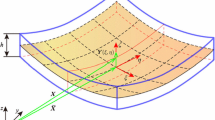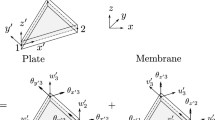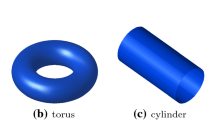Abstract
A thin shell formulation is developed for the approximation by a meshfree Reproducing Kernel Particle Method (RKPM). The formulation is derived from a degenerated shell approach where the structure is treated as a 3D solid subjected to kinematic constraints of the Kirchhoff–Love (KL) shell theory. To address the challenge of surface geometry representation in a meshfree method, a local parameterization using principal component analysis (PCA) is employed. Taylor-series expansion adapted to the shell formulation is developed to address the accuracy and stability issues of nodal quadrature. Several approaches that address membrane locking are also considered. The effectiveness of the proposed RKPM KL shell formulation is demonstrated using an extensive set of linear-elastic and finite-deformation inelastic test cases.




























Similar content being viewed by others
Data availability
No datasets were generated or analyzed during the current study.
References
Kiendl J, Bletzinger K-U, Linhard J, Wüchner R (2009) Isogeometric shell analysis with Kirchhoff-Love elements. Comput Methods Appl Mech Eng 198(49–52):3902–3914
Timoshenko S, Woinowsky-Krieger S (1959) Theory of plates and shells. McGraw-Hill, New York
Benson DJ, Hallquist JO (1990) A single surface contact algorithm for the post-buckling analysis of shell structures. Comput Methods Appl Mech Eng 78(2):141–163
LST (2007) Corporation, LS-DYNA keyword user’s manual
Ahmad S, Irons BM, Zienkiewicz O (1970) Analysis of thick and thin shell structures by curved finite elements. Int J Numer Methods Eng 2(3):419–451
Hughes TJ, Liu WK (1981) Nonlinear finite element analysis of shells: Part I. three-dimensional shells. Comput Methods Appl Mech Eng 26(3):331–362
Belytschko T, Lin JI, Chen-Shyh T (1984) Explicit algorithms for the nonlinear dynamics of shells. Comput Methods Appl Mech Eng 42(2):225–251
Belytschko T, Stolarski H, Liu WK, Carpenter N, Ong JS (1985) Stress projection for membrane and shear locking in shell finite elements. Comput Methods Appl Mech Eng 51(1–3):221–258
Simo JC, Fox DD (1989) On a stress resultant geometrically exact shell model Part I: Formulation and optimal parametrization. Comput Methods Appl Mech Eng 72(3):267–304
Simo J, Fox D, Rifai M (1989) On a stress resultant geometrically exact shell model Part II: The linear theory; computational aspects. Comput Methods Appl Mech Eng 73(1):53–92
Simo JC, Fox DD, Rifai MS (1990) On a stress resultant geometrically exact shell model Part III: Computational aspects of the nonlinear theory. Comput Methods Appl Mech Eng 79(1):21–70
Benson DJ, Bazilevs Y, Hsu M-C, Hughes T (2010) Isogeometric shell analysis: the Reissner-Mindlin shell. Comput Methods Appl Mech Eng 199(5–8):276–289
Chen J-S, Wang D (2006) A constrained reproducing kernel particle formulation for shear deformable shell in Cartesian coordinates. Int J Numer Methods Eng 68(2):151–172
Peng Y, Zhang A, Ming F (2018) A thick shell model based on reproducing kernel particle method and its application in geometrically nonlinear analysis. Comput Mech 62:309–321
Zhang Q, Li S, Zhang A-M, Peng Y, Yan J (2021) A peridynamic Reissner-Mindlin shell theory. Int J Numer Methods Eng 122(1):122–147
Krysl P, Chen J-S (2023) Benchmarking computational shell models. Arch Comput Methods Eng 30(1):301–315
Gingold RA, Monaghan JJ (1977) Smoothed particle hydrodynamics: theory and application to non-spherical stars. Mon Not R Astron Soc 181(3):375–389
Nayroles B, Touzot G, Villon P (1992) Generalizing the finite element method: diffuse approximation and diffuse elements. Comput Mech 10(5):307–318
Belytschko T, Lu YY, Gu L (1994) Element-free Galerkin methods. Int J Numer Methods Eng 37(2):229–256
Liu WK, Jun S, Zhang YF (1995) Reproducing kernel particle methods. Int J Numer Methods Fluids 20(8–9):1081–1106
Wang D, Wang J, Wu J (2020) Arbitrary order recursive formulation of meshfree gradients with application to superconvergent collocation analysis of kirchhoff plates. Comput Mech 65(3):877–903
Guan P, Chi S, Chen J, Slawson T, Roth M (2011) Semi-lagrangian reproducing kernel particle method for fragment-impact problems. Int J Impact Eng 38(12):1033–1047
Chen J-S, Hillman M, Chi S-W (2017) Meshfree methods: progress made after 20 years. J Eng Mech 143(4):04017001
Wang J, Zhou G, Hillman M, Madra A, Bazilevs Y, Du J, Su K (2021) Consistent immersed volumetric nitsche methods for composite analysis. Comput Methods Appl Mech Eng 385:114042
Nguyen H, Wang J, Bazilevs Y (2024) A smooth crack-band model for anisotropic materials: Continuum theory and computations with the rkpm meshfree method. Int J Solids Struct 112:618
Krysl P, Belytschko T (1996) Analysis of thin shells by the element-free Galerkin method. Int J Solids Struct 33(20–22):3057–3080
Noguchi H, Kawashima T, Miyamura T (2000) Element free analyses of shell and spatial structures. Int J Numer Methods Eng 47(6):1215–1240
Rabczuk T, Areias P, Belytschko T (2007) A meshfree thin shell method for non-linear dynamic fracture. Int J Numer Methods Eng 72(5):524–548
Behzadinasab M, Alaydin M, Trask N, Bazilevs Y (2022) A general-purpose, inelastic, rotation-free Kirchhoff-Love shell formulation for peridynamics. Comput Methods Appl Mech Eng 389:114422
Hughes TJ, Cottrell JA, Bazilevs Y (2005) Isogeometric analysis: CAD, finite elements, NURBS, exact geometry and mesh refinement. Comput Methods Appl Mech Eng 194(39–41):4135–4195
Cottrell JA, Hughes TJ, Bazilevs Y (2009) Isogeometric analysis: toward integration of CAD and FEA. John Wiley & Sons, Berlin
Kiendl J, Hsu M-C, Wu MC, Reali A (2015) Isogeometric Kirchhoff-Love shell formulations for general hyperelastic materials. Comput Methods Appl Mech Eng 291:280–303
Ambati M, Kiendl J, De Lorenzis L (2018) Isogeometric Kirchhoff-Love shell formulation for elasto-plasticity. Comput Methods Appl Mech Eng 340:320–339
Kiendl J, Ambati M, De Lorenzis L, Gomez H, Reali A (2016) Phase-field description of brittle fracture in plates and shells. Comput Methods Appl Mech Eng 312:374–394
Proserpio D, Ambati M, De Lorenzis L, Kiendl J (2021) Phase-field simulation of ductile fracture in shell structures. Comput Methods Appl Mech Eng 385:114019
Deng X, Korobenko A, Yan J, Bazilevs Y (2015) Isogeometric analysis of continuum damage in rotation-free composite shells. Comput Methods Appl Mech Eng 284:349–372
Bazilevs Y, Pigazzini M, Ellison A, Kim H (2018) A new multi-layer approach for progressive damage simulation in composite laminates based on isogeometric analysis and Kirchhoff-Love shells. Part I: basic theory and modeling of delamination and transverse shear. Comput Mech 62:563–585
Pigazzini M, Bazilevs Y, Ellison A, Kim H (2018) A new multi-layer approach for progressive damage simulation in composite laminates based on isogeometric analysis and Kirchhoff-Love shells. Part II: impact modeling. Comput Mech 62:587–601
Benson DJ, Bazilevs Y, Hsu M-C, Hughes T (2011) A large deformation, rotation-free, isogeometric shell. Comput Methods Appl Mech Eng 200(13–16):1367–1378
Benson D, Hartmann S, Bazilevs Y, Hsu M-C, Hughes T (2013) Blended isogeometric shells. Comput Methods Appl Mech Eng 255:133–146
Alaydin MD, Benson DJ, Bazilevs Y (2021) An updated lagrangian framework for isogeometric Kirchhoff-Love thin-shell analysis. Comput Methods Appl Mech Eng 384:113977
Alaydin M, Behzadinasab M, Bazilevs Y (2022) Isogeometric analysis of multilayer composite shell structures: Plasticity, damage, delamination and impact modeling. Int J Solids Struct 252:111782
Alaydin MD, Bazilevs Y (2023) Multilayer shells interacting through friction. J Appl Mech 90(12):121012
Hosseini S, Remmers JJ, Verhoosel CV, De Borst R (2013) An isogeometric solid-like shell element for nonlinear analysis. Int J Numer Methods Eng 95(3):238–256
Stolarski H, Belytschko T (1982) Membrane locking and reduced integration for curved elements. J Appl Mech 49(1):172–176
Casquero H, Golestanian M (2022) Removing membrane locking in quadratic NURBS-based discretizations of linear plane Kirchhoff rods: CAS elements. Comput Methods Appl Mech Eng 399:115354
Huang H-C (1987) Membrane locking and assumed strain shell elements. Comput Struct 27(5):671–677
Beissel S, Belytschko T (1996) Nodal integration of the element-free Galerkin method. Comput Methods Appl Mech Eng 139(1–4):49–74
Liu WK, Ong JS-J, Uras RA (1985) Finite element stabilization matrices-a unification approach. Comput Methods Appl Mech Eng 53(1):13–46
Hillman M, Chen J-S (2016) An accelerated, convergent, and stable nodal integration in Galerkin meshfree methods for linear and nonlinear mechanics. Int J Numer Methods Eng 107(7):603–630
Moutsanidis G, Li W, Bazilevs Y (2021) Reduced quadrature for FEM, IGA and meshfree methods. Comput Methods Appl Mech Eng 373:113521
Wold S, Esbensen K, Geladi P (1987) Principal component analysis. Chemometrics Intell Lab Syst 2(1–3):37–52
Trask N, Kuberry P (2020) Compatible meshfree discretization of surface PDEs. Comput Particle Mech 7(2):271–277
Chen J-S, Pan C, Wu C-T, Liu WK (1996) Reproducing kernel particle methods for large deformation analysis of non-linear structures. Comput Methods Appl Mech Eng 139(1–4):195–227
Wang J, Behzadinasab M, Li W, Bazilevs Y (2024) A stable formulation of correspondence-based peridynamics with a computational structure of a method using nodal integration. Int J Numer Methods Eng 125(11):e7465
Li W, Moutsanidis G, Behzadinasab M, Hillman M, Bazilevs Y (2022) Reduced quadrature for finite element and isogeometric methods in nonlinear solids. Comput Methods Appl Mech Eng 399:115389
Newmark NM (1959) A method of computation for structural dynamics. J Eng Mech Div 85(3):67–94
Johnson GC, Bammann DJ (1984) A discussion of stress rates in finite deformation problems. Int J Solids Struct 20(8):725–737
Flanagan D, Taylor L (1987) An accurate numerical algorithm for stress integration with finite rotations. Comput Methods Appl Mech Eng 62(3):305–320
Simo JC, Hughes TJ (2006) Computational inelasticity. Springer Science & Business Media, Berlin
Bischoff M, Bletzinger K-U, Wall WA, Ramm E (2004) Models and Finite Elements for Thin-Walled Structures. John Wiley & Sons, Berlin
Bazilevs Y, Hsu M-C, Benson DJ, Sankaran S, Marsden AL (2009) Computational fluid-structure interaction: methods and application to a total cavopulmonary connection. Comput Mech 45:77–89
Belytschko T, Liu WK, Moran B, Elkhodary K (2014) Nonlinear finite elements for continua and structures. John wiley & Sons, Berlin
Kiendl J, Bazilevs Y, Hsu M-C, Wüchner R, Bletzinger K-U (2010) The bending strip method for isogeometric analysis of kirchhoff-love shell structures comprised of multiple patches. Comput Methods Appl Mech Eng 199(37–40):2403–2416
Raknes S, Deng X, Bazilevs Y, Benson D, Mathisen K, Kvamsdal T (2013) Isogeometric rotation-free bending-stabilized cables: Statics, dynamics, bending strips and coupling with shells. Comput Methods Appl Mech Eng 263:127–143
Guo Y, Zou Z, Ruess M (2021) Isogeometric multi-patch analyses for mixed thin shells in the framework of non-linear elasticity. Comput Methods Appl Mech Eng 380:113771
Kamensky D, Xu F, Lee C-H, Yan J, Bazilevs Y, Hsu M-C (2018) A contact formulation based on a volumetric potential: Application to isogeometric simulations of atrioventricular valves. Comput Methods Appl Mech Eng 330:522–546
Belytschko T, Yeh I (1993) The splitting pinball method for contact-impact problems. Comput Methods Appl Mech Eng 105(3):375–393
Kamensky D, Hsu M-C, Schillinger D, Evans JA, Aggarwal A, Bazilevs Y, Sacks MS, Hughes TJ (2015) An immersogeometric variational framework for fluid-structure interaction: Application to bioprosthetic heart valves. Comput Methods Appl Mech Eng 284:1005–1053
Bower AF (2009) Applied mechanics of solids. CRC Press, Berlin
Fernández-Méndez S, Huerta A (2004) Imposing essential boundary conditions in mesh-free methods. Comput Methods Appl Mech Eng 193(12–14):1257–1275
Behzadinasab M, Trask N, Bazilevs Y (2021) A unified, stable and accurate meshfree framework for peridynamic correspondence modeling-Part I: Core methods. J Peridynam Nonlocal Model 3(1):24–45
Wang D, Wang J, Wu J (2018) Superconvergent gradient smoothing meshfree collocation method. Comput Methods Appl Mech Eng 340:728–766
Hillman M, Pasetto M, Zhou G (2020) Generalized reproducing kernel peridynamics: unification of local and non-local meshfree methods, non-local derivative operations, and an arbitrary-order state-based peridynamic formulation. Comput Particle Mech 7(2):435–469
Wang J, Hillman M (2024) Upwind reproducing kernel collocation method for convection-dominated problems. Comput Methods Appl Mech Eng 420:116711
Han W, Meng X (2001) Error analysis of the reproducing kernel particle method. Comput Methods Appl Mech Eng 190(46–47):6157–6181
Wu J, Wang D (2021) An accuracy analysis of galerkin meshfree methods accounting for numerical integration. Comput Methods Appl Mech Eng 375:113631
Scordelis A, Lo K (1964) Computer analysis of cylindrical shells. J Am Concrete Inst 61(5):539–562
Areias PM, Ritto-Corrêa MC, Martins JA (2010) Finite strain plasticity, the stress condition and a complete shell model. Comput Mech 45:189–209
Tarigopula V, Langseth M, Hopperstad OS, Clausen AH (2006) Axial crushing of thin-walled high-strength steel sections. Int J Impact Eng 32(5):847–882
Kazancı Z, Bathe K-J (2012) Crushing and crashing of tubes with implicit time integration. Int J Impact Eng 42:80–88
Peng Y-X, Zhang A-M, Ming F-R (2021) Numerical simulation of structural damage subjected to the near-field underwater explosion based on sph and rkpm. Ocean Eng 222:108576
Parisch H (1979) A critical survey of the 9-node degenerated shell element with special emphasis on thin shell application and reduced integration. Comput Methods Appl Mech Eng 20(3):323–350
Armero F, Valverde J (2012) Invariant hermitian finite elements for thin Kirchhoff rods. I: The linear plane case. Comput Methods Appl Mech Eng 213:427–457
Wang J, Hillman M, Wilmes D, Magallanes J, Bazilevs, Y (2024) Smoothed naturally stabilized RKPM for non-linear explicit dynamics with novel stress gradient update. Comput Mech, https://doi.org/10.1007/s00466-024-02494-0.
Acknowledgements
This work was supported through the ONR Grant No. N00014-21-1-2670. J. Wang was also supported by the Hibbitt Postdoctoral Fellowship in the School of Engineering at Brown University.
Author information
Authors and Affiliations
Corresponding author
Rights and permissions
Springer Nature or its licensor (e.g. a society or other partner) holds exclusive rights to this article under a publishing agreement with the author(s) or other rightsholder(s); author self-archiving of the accepted manuscript version of this article is solely governed by the terms of such publishing agreement and applicable law.
About this article
Cite this article
Wang, J., Bazilevs, Y. A general-purpose meshfree Kirchhoff–Love shell formulation. Engineering with Computers (2024). https://doi.org/10.1007/s00366-024-01989-x
Received:
Accepted:
Published:
DOI: https://doi.org/10.1007/s00366-024-01989-x




